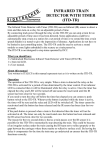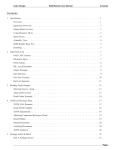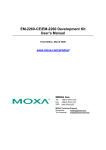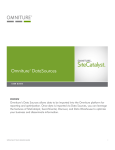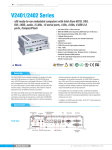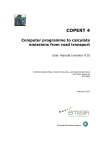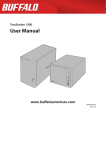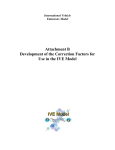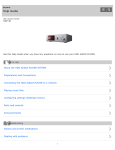Download V2401/2402-CE User`s Manual - Express Systems & Peripherals
Transcript
V2401/2402 Series WinCE User’s Manual First Edition, March 2010 www.moxa.com/product 2010 Moxa Inc. All rights reserved. Reproduction without permission is prohibited. V2401/2402 Series WinCE User’s Manual The Moxa software described in this manual is furnished under a license agreement and may be used only in accordance with the terms of that agreement. Copyright Notice Copyright 2010 Moxa Inc. All rights reserved. Reproduction without permission is prohibited. Trademarks MOXA is a registered trademark of Moxa Inc. All other trademarks or registered marks in this manual belong to their respective manufacturers. Disclaimer Information in this document is subject to change without notice and does not represent a commitment on the part of Moxa. Moxa provides this document “as is,” without warranty of any kind, either expressed or implied, including, but not limited to, its particular purpose. Moxa reserves the right to make improvements and/or changes to this manual, or to the products and/or the programs described in this manual, at any time. Information provided in this manual is intended to be accurate and reliable. However, Moxa assumes no responsibility for its use, or for any infringements on the rights of third parties that may result from its use. This product might include unintentional technical or typographical errors. Changes are periodically made to the information herein to correct such errors, and these changes are incorporated into new editions of the publication. Technical Support Contact Information www.moxa.com/support Moxa Americas: Toll-free: 1-888-669-2872 Tel: +1-714-528-6777 Fax: +1-714-528-6778 Moxa China (Shanghai office): Toll-free: 800-820-5036 Tel: +86-21-5258-9955 Fax: +86-10-6872-3958 Moxa Europe: Tel: +49-89-3 70 03 99-0 Fax: +49-89-3 70 03 99-99 Moxa Asia-Pacific: Tel: +886-2-8919-1230 Fax: +886-2-8919-1231 Table of Contents Chapter 1 Introduction ..................................................................................................1-1 Overview.................................................................................................................................. 1-2 Software Specifications ........................................................................................................... 1-2 Application Development Environment ....................................................................... 1-2 Networking and Communication Capabilities.............................................................. 1-3 Supporting Services and Daemons ............................................................................... 1-3 Graphics Tools.............................................................................................................. 1-3 Supporting Drivers ....................................................................................................... 1-4 Firmware Build Versions ......................................................................................................... 1-4 Memory and File Systems ....................................................................................................... 1-4 Hive-Based Registry ................................................................................................................ 1-4 Chapter 2 Software Configuration ...............................................................................2-1 Starting Your V2401/2402-CE Computer ................................................................................ 2-2 Resetting Your V2401/2402-CE Computer.............................................................................. 2-3 Cold-Start ..................................................................................................................... 2-3 Warm-Start ................................................................................................................... 2-3 Changing the Network Settings ............................................................................................... 2-3 Operating Your V2401/2402 Computer with a Telnet Client................................................... 2-4 User/Group Management......................................................................................................... 2-5 Adjusting the System Time ...................................................................................................... 2-5 Adjusting the Time Zone ......................................................................................................... 2-6 Starting and Stopping Services ................................................................................................ 2-6 Troubleshooting Network Connectivity................................................................................... 2-6 Simple Network Management Protocol (SNMP)..................................................................... 2-8 Setting Up the Displays ........................................................................................................... 2-9 Inserting a USB Storage Device into the Computer................................................................2-11 4 RS-232/422/485 Serial Ports and 8 RS-232 Serial Ports .....................................................2-11 Accessing Files through File Sharing .................................................................................... 2-12 BIOS Status Notification ....................................................................................................... 2-13 How to Determine the Firmware Build Version..................................................................... 2-14 Chapter 3 Management Tools.......................................................................................3-1 System Information.................................................................................................................. 3-2 Process (Thread) Monitoring/Control...................................................................................... 3-3 Services Monitoring/Services .................................................................................................. 3-4 Serial Port Configuration ......................................................................................................... 3-5 Display Configuration.............................................................................................................. 3-6 Auto Launch Configuration ..................................................................................................... 3-7 User/Group Management......................................................................................................... 3-8 Web Server Configuration ..................................................................................................... 3-10 Chapter 4 System Recovery .........................................................................................4-1 Reset to Factory Default .......................................................................................................... 4-2 Recovery Procedure ................................................................................................................. 4-4 Recovery Environment ................................................................................................. 4-4 Appendix A Firmware Upgrade Procedure.................................................................... A-1 1 Chapter 1 Introduction Thank you for purchasing the Moxa V2401/2402 Series of x86 ready-to-run embedded computers. This manual introduces the software configuration and management of V2401/2402 embedded computers running the Windows CE operating system. For hardware installation, connector interfaces, setup, and upgrading the BIOS, please refer to the V2401/2402 Series Hardware User’s Manual. Microsoft Windows CE is an open, scalable, 32-bit operating system that allows you to build a wide range of innovative, small footprint devices. A typical Windows CE-based device is designed for a specific use, and often runs disconnected from other computers, or distributed as a front-end to a centralized host. Examples include enterprise tools, such as industrial controllers, communications hubs, point-of-sale terminals, and display devices, such as HMI, advertisement appliances, and interactive panels. This chapter covers the following topics: Overview Software Specifications Application Development Environment Networking and Communication Capabilities Supporting Services and Daemons Graphics Tools Supporting Drivers Memory and File Systems Hive-Based Registry V2401/2402 Series WinCE User’s Manual Introduction Overview The V2401/2402 Series embedded computers are based on the Intel Atom N270 x86 processor, and feature 4 RS-232/422/485 serial ports, 8 RS-232 serial ports, dual Gigabit LAN ports, 6 USB 2.0 hosts, and a CompactFlash socket. The V2401 computer provides VGA, DVI, and LVDS outputs, and the V2402 computer provides both VGA and DVI outputs, making them particularly well-suited for industrial applications such as SCADA and factory automation. The V2401 and V2402 come with 4 RS-232/422/485 serial ports, and the V2401 has an additional 8 RS-232 ports, making them ideal for connecting a wide range of serial devices, and the dual 10/100/1000 Mbps Ethernet ports offer a reliable solution for network redundancy, promising continuous operation for data communication and management. As an added convenience, the V2401/2402 computers have 4 DIs, and 4 DOs for connecting digital input/output devices. In addition, the CompactFlash and USB sockets provide the V2401/2402 computers with the reliability needed for industrial applications that require data buffering and storage expansion. Pre-installed with the Windows CE 6.0 operating system, the V2401/2402 Series provides programmers with a friendly environment for developing sophisticated, bug-free application software at a low cost. Software Specifications The V2401/2402-CE embedded computer provides the following common, popular application development features, networking/communications capabilities and supporting services/daemons to make the Windows CE environment into an easy and convenient programming tool. The software features of the V2401/2402-CE embedded computer are listed below: Application Development Environment Microsoft .Net Compact Framework 3.5—Microsoft .NET CF is a software package designed by Microsoft for connecting information, people, systems, and devices. One of the main features of .Net CF is the use of XML Web services, which allow small, discrete, building-block applications to connect to each other and to other, larger applications over the Internet. Microsoft Visual Studio .NET and the Microsoft .NET Framework allow developers to develop XML Web services quickly, and integrate them easily with other applications. C/C++ Programming Languages—You can use the eVC4++ or Visual Studio 2005 to develop C/C++ programs. COM and DCOM—The Component Object Model (COM) is a platform-independent, object-oriented system for creating binary software components that can interact with other COM-based components in the same process space, in other processes, or on remote devices. Message Queuing (MSMQ) —The Message Queuing (MSMQ) implementation makes it possible for applications to communicate with other applications across networks and systems that might be temporarily offline. SOAP Toolkit—The client-side SOAP Toolkit functionality in Microsoft Windows CE allows an application to invoke Web service operations while the server-side functionality maps invoked Web service operations to Component Object Model (COM) object method calls. XML—Extensible Markup Language (XML) is the universal format for data on the Web. XML allows developers to describe and deliver rich, structured data from any application in a standard, consistent way. XML does not replace HTML, but is a complementary format. 1-2 V2401/2402 Series WinCE User’s Manual Introduction Networking and Communication Capabilities Simple Network Management Protocol (SNMP)—Monitors remote connections to the network. Simple Network Time Protocol (SNTP) Client—Provides support for synchronizing the device’s system time with an SNTP server, and supports Daylight Saving Time. Serial Communications—Includes a special driver for Moxa serial ports. Network Utilities (IpConfig, Ping, Route)—Utilities for troubleshooting various network problems. TCP/IP—Includes IP, Address Resolution Protocol (ARP), Internet Control Message Protocol (ICMP), Internet Group Membership Protocol (IGMP), Transmission Control Protocol (TCP), User Datagram Protocol (UDP), name resolution and registration, DNS Client, and DHCP. Dial-up Networking—Consists of RAS client API and the Point to Point Protocol (PPP). RAS and PPP support Extensible Authentication Protocol (EAP) and RAS scripting PPPoE—Point-to-Point Protocol over Ethernet (PPPoE) provides the ability to connect a network of hosts, over a simple bridging access device, to a Remote Access Concentrator. Supporting Services and Daemons FTP Server—A sample server used for transferring files to and from remote computer systems over a network using TCP/IP. File Server—The File Server functionality in Microsoft® Windows® CE enables clients to access files and other resources over the network. Telnet Server—A sample server that allows remote administration through a standard telnet client. Web Server (IIS)—Includes ASP, ISAPI, and Web Administration ISAPI Extensions. Graphics Tools Graphics Device Interface (GDI)—Provides information about the fundamental graphics architecture for Windows CE. Diect3D Mobile Display Drivers—Provides information about creating a display driver that supports Direct3D Mobile. DirectDraw Display Drivers—Provides information about creating a display driver that supports DirectDraw. Audio Codecs and Renderers G.711 Audio Codec GSM 6.10 Audio Codec IMA ADPCM Audio Codec MP3 Codec MPEG-I Layer 1 and 2 Audio Codec MS ADPCM Audio Codec Wave/AIFF/au/snd File Parser Waveform Audio Renderer WMA Codec WMA Voice Codec WMAPro over S/PDIF Packetizer 1-3 V2401/2402 Series WinCE User’s Manual Introduction Video Codecs and Renderers DirectShow Video Renderer MPEG-I Video Codec MS RLE Video Codec Video/Image Compression Manager WMV/MEPG-4 Video Codec Supporting Drivers Watchdog Driver—Provides a Watchdog API for use with applications. BIOS Alarm Driver –Provides the BIOS status API for use with applications. Firmware Build Versions There are two ways to obtain the firmware version of a V2401/2402-CE embedded computer. This information is particularly important for feature identification purposes. Use command sysinfo to view the system information. Execute the System Manager application (described in a later chapter) to view the system information. Memory and File Systems The V2401/2402 has 1 GB of SDRAM space built-in; however, the available memory space is 512 MB due to the limitations imposed by Windows CE 6.0. The main memory has a capacity of about 480 MB in which the operating system and user applications run. The kernel image occupies the rest of the space. The V2401/2402-CE's internal file system controls access to the compact flash card and a RAM disk. The file system provides persistent storage for applications and related data, even when the main power supply is lost. When the system resets, all files stored in RAM disk will be lost. The root directory is a ROM file system, which differs from the system used by Moxa’s UC-7400-CE embedded computer. The V2401/2402-CE root file system is a persistent file system. There is no any RAM file system stored in V2401/2402-CE. The internal file system is uses a FAT (File Allocation Table). This means that the internal file system of the computer provides the ability to mount external FAT file systems. The additional file systems on USB and CompactFlash storage devices are placed at the root of the internal file system. If you intend to use these devices to port data between your PC and the V2401/2402 computer, please format them as the FAT file system on your PC. Hive-Based Registry The registry for the V2401/2402-CE is a hive-based registry, in contrast to a RAM-based registry. The hive-based registry stores registry data inside files, or hives, which can be kept in a file system, which removes the need for performing backup and restore on power off. The registry data is stored in the \Registry directory. 1-4 2 Chapter 2 Software Configuration In this chapter, we explain how to operate a V2401/2402-CE computer either directly, or from a PC over the network. In addition, we explain how to handle system time adjustment, troubleshoot network connectivity, and other operations. Some of these operations can be handled with system commands after gaining access to the computer, and others can be done by using a “System Manager” described in a later chapter. This chapter covers the following topics: Starting Your V2401/2402-CE Computer Resetting Your V2401/2402-CE Computer Cold-Start Warm-Start Changing the Network Settings Operating Your V2401/2402 Computer with a Telnet Client User/Group Management Adjusting the System Time Adjusting the Time Zone Starting and Stopping Services Troubleshooting Network Connectivity Simple Network Management Protocol (SNMP) Setting Up the Displays Inserting a USB Storage Device into the Computer Accessing Files through File Sharing BIOS Status Notification How to Determine the Firmware Build Version V2401/2402 Series WinCE User’s Manual Software Configuration Starting Your V2401/2402-CE Computer Connect the display monitor to the V2401/2402-CE computer, and then power it up by connecting it to the power adaptor. It takes about 30 to 40 seconds for the system to boot up. During the boot-up process you should see the “Windows Embedded CE 6.0” loader image displayed on your monitor, along with a progress bar. Once the system is ready, the desktop will appear on your monitor. 2-2 V2401/2402 Series WinCE User’s Manual Software Configuration Resetting Your V2401/2402-CE Computer Cold-Start Press power button and then press it again. The computer will reboot itself right away. Warm-Start To reboot the computer when the power is on, push the reset button on the rear panel and then release it within 1 second. The computer will reboot itself. Changing the Network Settings The V2401/2402-CE computer comes with two network interfaces. The default IP addresses and netmasks of the network interfaces are as follows: LAN 1 LAN 2 Default IP Address 192.168.3.127 192.168.4.127 Netmask 255.255.255.0 255.255.255.0 There are two ways for you to change your network setting. Use Windows CE Network Control Panel utility Step1: Move you mouse go to the [Start] [Settings] [Network and Dial-Up Connections]. Step2: Right-Click the LAN icon and click the [Properties] Step3: Click “OK” button after configuration is done. 2-3 V2401/2402 Series WinCE User’s Manual Software Configuration Use telnet client to logon to V2401/2402 Normally, you are required to change them because they are located on a different local network from that of your development workstation. Without changes, you cannot connect to them directly. Use the netconfig utility to complete the task. Type netconfig -h to get help on this utility. \> netconfig -h Usage: netconfig -n <AdapterName | Alias> [-EnableDHCP] [-i <IP address>] [-m <netmask>] [-g <gateway>] [-d <DNS server>] [-w <WINS Server>] [-noask] e.g.: netconfig -n LAN1 -i 192.168.10.101 -g 192.168.10.254 : netconfig -n LAN1 -EnableDHCP Alias: LAN1=PCI\RTCENIC1 LAN2=PCI\RTCENIC2 For example, your development workstation has a LAN port at 192.168.1.5 and the Domain Name Server (DNS) is at 192.168.2.6. Execute the following command. \> netconfig –n LAN1 –i 192.168.1.5 –m 255.255.255.0 –g 192.168.1.254 –d 192.168.2.6 Use command netconfig to view the new settings. \> netconfig Ethernet Adapter [PCI\RTCENIC1] IP Address: 192.168.1.5 SubNet Mask: 255.255.255.0 Gateway: 192.168.1.254 DNS: 192.168.2.6 Ethernet Adapter [PCI\RTCENIC2] IP Address: 192.168.4.127 SubNet Mask: 255.255.255.0 Gateway: DNS: Operating Your V2401/2402 Computer with a Telnet Client Before using the Telnet client, we suggest that you change the network settings of the computer (see the section “Changing the Network Settings”) so that at least one of the network ports is situated in the same subnet segment as your development workstation. Use a crossover Ethernet cable to connect your development workstation directly to the target computer, or use a straight-through Ethernet cable to connect the computer to a LAN hub or switch. Next, use a Telnet client on your development workstation to connect to the Telnet console utility of the target computer. After a connection has been established, type the login name and password as requested to log on to the computer. 2-4 V2401/2402 Series WinCE User’s Manual Software Configuration After logging in through the Telnet client, a list of commands will be available for operating the computer. Use HELP to display all of the commands, or type HELP [command name] to display extended help for the selected command. Some of these commands, such as DATE and TIME, are very useful for managing the computer’s system time. Other commands, such as DIR and MKDIR, are good utilities for file management. For example, to inspect the file structure of the root directory, type DIR. \> dir /b BLDR SPLASH.BMX EBOOT.BIX BOOT.INI NK.BIN NK8.BIN Windows Temp Registry Program Files My Documents Control Panel.lnk Documents and Settings Application Data ATTENTION You can only create 9 WinCE Telnet clients at the same time. User/Group Management List Current User: Use the command userlist to display the information of existing users. \> userlist Admin (ftpd, telnetd, administrators) Adjusting the System Time Setting the System Time Manually Use the date and time command line utilities to query the current system date/time or set a new system date/time. \> date The current date is: Monday, January 04, 2010 Enter the new date (mm-dd-[yy]yy): 01-04-10 \> date /T Monday, January 04, 2010 \> time The current time is: 4:02:00 PM Enter the new time (hh:mm:ss): 16:02:00 2-5 V2401/2402 Series WinCE User’s Manual Software Configuration \> time /T 4:02:04 PM Adjusting the Time Zone Windows CE 6.0 supports Time Zone setting. You can use Control Panel Date/Time to adjust your current Time Zone. Daylight saving Date and Daylight saving Time are also supported. Starting and Stopping Services After boot-up, the V2401/2402-CE computer runs several services continuously to serve requests from users or other programs. Notable services include Telnet (“TEL0:”), world wide web HTTP (“HTP0:”), and file transfer FTP (“FTP0:”). Services can be started or stopped by using the name of the service with the command “services.” For example, use the following command to start the FTP service: \> services start FTP0: Use the following command to Stop the FTP service: \> services stop FTP0: The V2401/2402-CE supports the following default services: TEL0: FTP0: Telnet Service FTP Service Troubleshooting Network Connectivity The ipconfig tool prints the TCP/IP-related configuration data of a host including the IP addresses, gateway and DNS servers. \> ipconfig /all Windows IP configuration Ethernet adapter Local Area Connection: IP Address ........ : 0.0.0.0 Subnet Mask ....... : 0.0.0.0 Adapter Name ...... : PCI\RTCENIC2 Description ....... : PCI\RTCENIC2 Adapter Index ..... : 3 Address............ : 00 90 e8 00 d6 73 DHCP Enabled....... : NO Primary WinsServer : Secondary WinsServer: Ethernet adapter Local Area Connection: IP Address ........ : 192.168.27.23 Subnet Mask ....... : 255.255.255.0 Default Gateway ... : 192.168.27.254 Adapter Name ...... : PCI\RTCENIC1 Description ....... : PCI\RTCENIC1 2-6 V2401/2402 Series WinCE User’s Manual Software Configuration Adapter Index ..... : 65538 Address............ : 00 90 e8 00 d6 72 DHCP Enabled....... : YES DHCP Server........ : 192.168.1.97 Primary WinsServer : 192.168.1.91 Secondary WinsServer: 192.168.1.93 Lease obtained on : Monday, January 4 ,2010 7 : 25 : 12 Lease expires on : Tuesday, January 5 ,2010 7 : 25 : 12 AutoConfig Enabled : YES Host name.......... : V2101-CE Domain Name........ : moxa.com DNS Servers........ : 192.168.1.91 192.168.1.93 192.168.1.97 NODETYPE........... : 8 Proxy Enabled...... : NO Routing Enabled.... : NO To troubleshoot network connectivity, reach ability, and name resolution, use the ping command. This command verifies IP-level connectivity to another TCP/IP computer by sending Internet Control Message Protocol (ICMP) Echo Request messages. The corresponding return Echo Reply messages are displayed, along with round-trip times. For more information, type ping without parameters. \> ping www.moxa.com Pinging Host www.moxa.com [192.168.1.16] Reply from 192.168.1.16: Echo size=32 time<1ms TTL=126 Reply from 192.168.1.16: Echo size=32 time<1ms TTL=126 Reply from 192.168.1.16: Echo size=32 time<1ms TTL=126 The route utility allows you to view or modify network routing tables. Type this command without parameters to view a list of functions. \> route To view current routing items in the tables, \> route PRINT To add a routing item on network interface 1, \> route ADD 192.168.0.0 MASK 255.255.0.0 192.168.15.254 To delete a routing item, \> route DELETE 192.168.0.0 2-7 V2401/2402 Series WinCE User’s Manual Software Configuration Simple Network Management Protocol (SNMP) SNMP is the standard Internet protocol for network management, and is part of the TCP/IP protocol suite. SNMP was developed to monitor and manage networks. It uses a distributed architecture that consists of agents and managers: SNMP Agent The SNMP agent is an SNMP application that monitors network traffic and responds to queries from SNMP manager applications. The agent also notifies the manager by sending a trap when significant events occur. SNMP Manager An SNMP manager is an SNMP application that generates queries to SNMP agent applications and receives traps from SNMP agent applications. The V2401/2402-CE computer installs an SNMP agent to serve as an SNMP device. You should install the SNMP manager on the workstation computer (for example, a Linux system) that monitors the network. After installing the nodes, you need to configure the SNMP manager and agent. To check SNMP agent capabilities for a target V2401/2402-CE computer (e.g, network IP at 192.168.3.127), log in to the workstation computer on which the SNMP manager resides. For example, for a Linux-based computer type: \> snmpwalk -v 2c -c public 192.168.3.127 system SNMPv2-MIB::sysDescr.0 = STRING: Microsoft Windows CE Version 6.0 (Build 2217) SNMPv2-MIB::sysObjectID.0 = OID: SNMPv2-SMI::enterprises.8691.13.2101 DISMAN-EVENT-MIB::sysUpTimeInstance = Timeticks: (7998235) 22:13:02.35 SNMPv2-MIB::sysContact.0 = STRING: MOXA Inc. Embedded Computing Business SNMPv2-MIB::sysName.0 = STRING: V2400-CE SNMPv2-MIB::sysLocation.0 = STRING:F8, No 6, Alley 6, Lane 235, Pao-Chiao Rd. Shing Tien City, Taipei, Taiwan, R.O.C. SNMPv2-MIB::sysServices.0 = INTEGER: 72 SNMPv2-MIB::sysORLastChange.0 = Timeticks: (0) 0:00:00.00 You will see a series of messages from the SNMP agent on the V2401/2402-CE computer. You will now be able to monitor and manage the computer. 2-8 V2401/2402 Series WinCE User’s Manual Software Configuration Setting Up the Displays The V2401-CE supports 3 display selections: CRT, DVI and LVDS). However, you can only activate two displays at the same time. You may configure the dual display setting in the System Manager. If you need to use dual displays with LVDS (VGA + LVDS or DVI + LDVS) you should configure it from the BIOS LVDS setting. BIOS configuration In the BIOS setting, select LCD Panel Type, and then select the correct resolution. LVDS synchronization utility After entering Windows CE, there is an auto-launching program for synchronizing the CRT (D-Sub) and LVDS. The utility will configure the setting automatically if the resolution of LVDS is not the same as CRT. The utility will perform the changes after 10 seconds if you do not cancel it. Note: If you use signal display, you can turn off the LVDS with the System Manager’s Display setting. 2-9 V2401/2402 Series WinCE User’s Manual Software Configuration To check the configuration, select the System Manager’s Display tab. 2-10 V2401/2402 Series WinCE User’s Manual Software Configuration Inserting a USB Storage Device into the Computer When the first USB storage device is plugged into the V2401/2402-CE, a directory named USBDisk under the root directory on the internal file system is created as a link to the storage area. The directory created for the second USB device is USBDisk2. ATTENTION We suggest formatting your USB Disk with the FAT format since the V2401/2402-CE does not support the NTFS format. 4 RS-232/422/485 Serial Ports and 8 RS-232 Serial Ports The V2401/2402-CE computer’s four RS-232/422/485 serial ports, listed from bottom to top, are named COM1, COM2, COM3 and COM4. Each of these ports supports baudrate settings up to 921,600 bps. The V2401-CE also offers 8 additional RS-232 serial ports. They are named COM5 through COM12. 2-11 V2401/2402 Series WinCE User’s Manual Software Configuration Accessing Files through File Sharing A file server function is provided for transferring files to the V2401/2402-CE. On PC, Click Start Run and input \\x.x.x.x to invoke the following login window. Note: x.x.x.x stands for V2401/2402-CE's IP address. After logging in, you will find 2 RS-232/422/485 Serial Ports that a file sharing folder has been created. To manage file sharing, type the “netshare -h” command from any command window (either Telnet or console). 2-12 V2401/2402 Series WinCE User’s Manual Software Configuration BIOS Status Notification The notification window provides users with immediate system status updates through the two following types of message: CMOS Checksum Error-Some situations, such as low battery or when the CMOS is cleared, will cause the CMOS checksum error and the notification window shows. Note: If you update the new bios and reboot the device, you will see the notification windows pop up because the checksum has been changed. Simply close the window for the new setting. Keyboard Error-If the keyboard was not installed in booting process, the notification window will pop up. In addition, you can get the status change by programming. For example, you can get “BIOS Status” from \examples\C++\ in the Software DVD. The code snippet is as follows: #define BIOS_CMOS_CHECKSUM 0x40 #define BIOS_KEYBOARD_ERROR 0x2 ErrorCode=Get_BIOS_Status(); Checksum_Error=(ErrorCode & BIOS_CMOS_CHECKSUM ? 1:0); Keyboard_Error=(ErrorCode & BIOS_KEYBOARD_ERROR ? 1:0); 2-13 V2401/2402 Series WinCE User’s Manual Software Configuration This function can be disabled or enabled by system manager; you can remove the auto launch item from system manager and enable it by adding the auto launch item under windows directory. The program name is “BIOSAlarm.exe”. How to Determine the Firmware Build Version Use the sysinfo command from the command line utility to obtain the firmware version. This information is particularly important for identifying which features your embedded computer supports. C:\> sysinfo Host: V2400-CE Firmware:V1.0 Build:10030921 .NetCF:3.5 Model Name:V2400-CE Memory: 450760704 / 474959872 (Bytes) File System Free Space: [\ ] 2064056320 / 2095022080 (Bytes) PCI\RTCENIC1=00-90-e8-00-d7-81 PCI\RTCENIC2=00-90-e8-00-d7-82 \> 2-14 3 Chapter 3 Management Tools The V2401/2402-CE ready-to-run embedded computer is shipped with Window CE operating system pre-installed. This operating system was designed to serve as a front-end for data acquisition and industrial control applications. A user-friendly management utility is also installed on each V2401/2402-CE computer to handle management issues. Before using this utility, make sure you have a display monitor connected to your V2401/2402-CE embedded computer, and then double-click the System Manager desktop icon. This chapter covers the following topics: System Information Process (Thread) Monitoring/Control Services Monitoring/Services Serial Port Configuration Display Configuration Auto Launch Configuration User/Group Management Web Server Configuration V2401/2402 Series WinCE User’s Manual Management Tools System Information The first page displays the V2401/2402-CE's system information, including the firmware version of the computer, .the Net CF version, the system time, and system resources, including the main memory and file system usage. 3-2 V2401/2402 Series WinCE User’s Manual Management Tools Process (Thread) Monitoring/Control You can use the management system to monitor and control processes or threads. The V2401/2402-CE computer can manage up to 32 processes. To view current processes, click the Processes item on the tab bar. Processes that are currently running will be displayed. You can kill a process by clicking the kill button. 3-3 V2401/2402 Series WinCE User’s Manual Management Tools Services Monitoring/Services Some services—such as FTP, Telnet and HTTP—run in the background. Select a checkbox to toggle a start/stop operation for a particular service. You can also adjust the time automatically by using SNTP. Select the checkbox to enable the service and then click the button next to the checkbox to activate it. In order to keep the computer running normally, some listed services cannot be stopped. This type of service does not have a checkbox next to it. 3-4 V2401/2402 Series WinCE User’s Manual Management Tools Serial Port Configuration The V2401/2402-CE has 4 RS-232/422/485 serial ports, and the V2401 has an additional 8 RS-232 serial ports. You may use the drop-down list to configure the operation mode. See the following figure for detailed information. 3-5 V2401/2402 Series WinCE User’s Manual Management Tools Display Configuration The V2401/2402-CE VGA output works through a CRT connector to display the Windows CE desktop on a LCD or CRT monitor. The default setting is “800x600”, 16 bit and 60Hz. For general purposes, you should tune the setting to match your LCD or CRT in specification. In the Display settings tab you can adjust the setting and press Apply to save the setting. And then click YES to restart your computer. The V2401/2402-CE also offers a DVI connector, and the V2401 even has an LVDS connector to connect an LVDS monitor. Please note that you can only use two displays at the same time. If you do not need to use the LVDS displays, you can select the VGA + DVI checkbox to set up the CRT resolution manually. The LVDS synchronization daemon will not perform the dual display check if VGA + DVI is checked. 3-6 V2401/2402 Series WinCE User’s Manual Management Tools ATTENTION You must restart (reboot) the system for the settings to take effect. Auto Launch Configuration You can specify programs to execute automatically after booting up. Click the Add button to add the program and restart the V2401/2402-CE to execute these programs. 3-7 V2401/2402 Series WinCE User’s Manual Management Tools User/Group Management You can add users by clicking the “Add” button to assign user name and group. And you can remove users by click the “Remove” button. 3-8 V2401/2402 Series WinCE User’s Manual Management Tools Enter the administrator password when you want to remove a user. 3-9 V2401/2402 Series WinCE User’s Manual Management Tools Web Server Configuration You can configure the V2401/2402-CE with an Internet browser. Your host must be running Windows 2000 or Windows XP to handle web administration. To do this, start Internet Explorer and then link to the url http://192.168.27.30/WebAdmin (if the V2401/2402's IP address is 192.168.27.30). After the logging in, you should see the standard Web Server Configuration page. 3-10 V2401/2402 Series WinCE User’s Manual Management Tools Click Modify to configure the default website, or CreateNew to configure a new website. To modify the default page, select the items you would like to configure. If you would like to create a new page, click OK in the following screen to continue. 3-11 V2401/2402 Series WinCE User’s Manual Management Tools You may also configure various website settings on these pages. When finished, you need to restart your browser, so that the configurations can take effect. 3-12 4 Chapter 4 System Recovery The V2401/2402-CE ready-to-run embedded computers run the Windows CE 6.0 operating system. In this chapter, we describe the recovery process that occurs in the event of system instability. This chapter covers the following topics: Reset to Factory Default Recovery Procedure Recovery Environment V2401/2402 Series WinCE User’s Manual System Recovery Reset to Factory Default There are two different ways to reset your V2401/2402 computer to factory defaults. Choose the option that best meets your requirements. Option 1 Follow the instructions below to reset to factory default during the boot process. This procedure will delete and restore all of your files to the factory default. 1. During the power on sequence, when you hear the beep press the 8 key before the WinCE loader image appears. 2. The V2401/2402-CE will automatically scan the file system and fix possible problems. Windows CE 6.0 supports the FAT file system. Sometimes the files, directories, or the FAT table can be damaged due to power fluctuations or application issues. The ScanDisk utility will scan the file system and attempt to fix any file or directory corruption problems. ATTENTION After you have run ScanDisk, you may find some files named FILE00xx.chk, which means that some files or directories were damaged and have been fixed. 3. When finished, you will see Are you sure you would like to reset the system configuration to the default? (y/n). Press Y to load factory default settings and the configuration files. 4. When you see Are you sure to clean all files? (y/n) you have the option to clear all garbage files and directories. 5. Next, you will see Proceeds? (y/n). Press Y to start the reset to factory default process. After the default configuration has been loaded, the system will reboot automatically. ATTENTION Performing this procedure will delete or restore to the factory default all of your files. 4-2 V2401/2402 Series WinCE User’s Manual System Recovery Option 2 Follow the instructions below to reset to factory default through the Control Panel of the Windows CE 6.0 OS. With this method, only the system configuration files are reset. 1. Double-click Reset to Default from the Control Panel. 2. Click Yes to continue, or No to cancel. 3. Click Yes in the next screen, or No to cancel. Once the default values have been loaded, the V2401/2402-CE computer will reboot, an the reset-to-default procedure will be complete. 4-3 V2401/2402 Series WinCE User’s Manual System Recovery ATTENTION When you use the method outlined in option 2, only system configuration files, such as network settings and system registry files, will be restored to the factory default. Other programs and folders will be unchanged. Recovery Procedure This section describes the recovery procedure. However, system recovery requires sophisticated operation and may damage your computer if not operated properly. Please contact Moxa’s technical support staff for all the necessary tools and assistance. Please follow the steps below. Recovery Environment The recovery environment includes the V2401/2402-CE embedded computer and a bootable USB disk with the recovery programs and system image file. V2401/2402-CE Bootable USB DISK (Recovery programs and system image file included) USB Port 4-4 V2401/2402 Series WinCE User’s Manual Step 1: System Recovery Format an Empty USB Disk. Use the HP USB Disk Format Tool. 1. Download the FreeDOS system files kernel.sys and command.com from http://www.freedos.org/kernel/ 2. Copy the DOS system files kernel.sys and command.com to a specified directory (in this example, C:\FreeDOS). 3. Start the HP USB Disk Storage Format Tool and select the USB device that you want to use as a bootable disk from the Device drop down box. 4. Select FAT from the File system drop down box. 5. Type the disk name in the Volume label field. 6. Check the option Create a DOS startup disk under format options. 7. Specify the directory of the system files (e.g., C:\FreeDOS). 8. Click Start to format and create the USB disk. ATTENTION The HP USB Disk Storage Format Tool can be downloaded from many different web sites. Type HP USB Disk Storage Format Tool to search the Internet, and then download it. 4-5 V2401/2402 Series WinCE User’s Manual Step 2: a. System Recovery Create a Windows CE Bootable USB Disk. The ceboot directory is located under \utility_tools\Recovery\CEBOOT on the CD shipped with V2401/2402-CE computer. b. Configure Windows Explorer to show hidden files (including protected operating system files). c. Copy all of the files in the ceboot directory to the root directory of your USB disk. 4-6 V2401/2402 Series WinCE User’s Manual Step 3: a. System Recovery Setup the BIOS to Boot from the USB Disk. Insert the USB disk. b. Power on and press DEL to enter the bios setup menu. c. Select Advanced Hard Disk Boot Priority and then press Enter. d. From the setup menu, use “↑” or “↓” to select the USB device e. Press “+” to move it up to the first priority, and press Esc to exit the setup menu. f. Make sure the first boot device is Hard Disk. If not, press Enter to change it. g. Select Exit Save & Exit Setup and then press Enter. h. Choose Y to save to the CMOS and then exit. 4-7 V2401/2402 Series WinCE User’s Manual System Recovery ATTENTION Please note that some USB disks will be detected as a Removable Device. If it happens, perform the following bios modification. a. Select Removable Device Priority. b. Make sure that the USB disk has been detected. Press Esc to exit. 4-8 V2401/2402 Series WinCE User’s Manual c. System Recovery Make sure that the First Boot Device is set to Removable. If not, select First Boot Device, press Enter and select it from the list. d. Select Exit Save & Exit Setup and then press Enter. e. Choose Y to save to the CMOS and then exit. Step 4: f. Recover Windows CE system from the USB Disk. If the BIOS setup is correct, it will restart and boot from the USB disk. g. Under command prompt, type cd ceboot. h. In the ceboot directory type mkdisk to execute the recovery procedure. i. When operation is complete, turn off the computer and remove the USB disk. ATTENTION DO NOT turn off power at this time, or the system may crash. Step 5: a. Reset the BIOS to boot from the DOM or CompactFlash Disk. Power on and press DEL to enter the bios setup menu. b. Select Advanced Hard Disk Boot Priority and then press Enter. c. From the setup menu, use “↑” or “↓” to select the DOM or CompactFlash device. d. Press “+” to move it up to the first priority, and press “Esc” to exit the setup menu. e. Select Exit Save & Exit Setup and then press Enter. f. Choose Y to save to the CMOS and then exit. g. Wait a few minutes for the system to boot up. When the recovery process is finished, you will again see the Windows CE desktop. 4-9 A Firmware Upgrade Procedure Appendix A Moxa’s engineers continuously enhance and develop software features to improve the quality and functionality of the embedded products, with new firmware available from Moxa’s download center. Take the following steps when you decide to replace your firmware. 1. Go to the Moxa download center to download an executable file for your computer; for example V2401/2402-CE_V1.0.09112414.exe. 2. Upload this file to the target machine under the root directory (i.e., \). If you place this file in a Compact Flash or a USB device, we suggest that you copy it to the root directory for a faster upgrade operation. Directly executing the program in a USB 1.1 device is very slow. 3. Log on to the target computer via a Telnet connection. 4. Execute this file. Press Y to continue the process. V2401/2402 Series WinCE User’s Manual Firmware Upgrade Procedure 5. The upgrade will take about 1 minute. After the upgrade is complete, select if you would like to keep the current network settings or restore the factory default values. Press Y to keep the current network settings. When the system restarts, the new firmware will be ready and running. A-2


















































